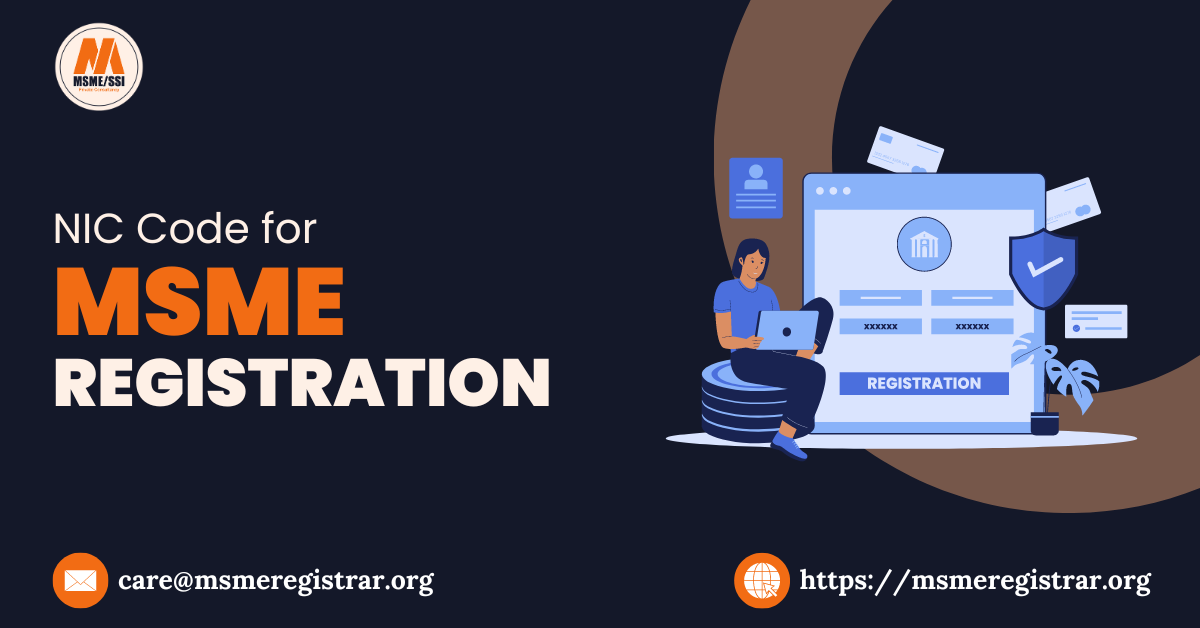Micro, Small, and Medium Enterprises (MSMEs) are the backbone of the Indian economy, contributing significantly to the country’s GDP and employment. To streamline their operations and encourage their growth, the Indian government has implemented various initiatives, including MSME registration. One of the critical components of MSME registration is the National Industrial Classification (NIC) code. Understanding the role and significance of the NIC code is crucial for MSME registration. This guide will explore the concept of the NIC code, its importance, and how it relates to MSME registration.
What is the NIC Code?
The National Industrial Classification (NIC) code is a statistical standard used to classify business activities in India. It was developed by the Central Statistical Organization (CSO) under the Ministry of Statistics and Programme Implementation. The NIC code serves as a standardized framework for identifying, analyzing, and comparing various economic activities. It is widely used in government surveys, censuses, and business registrations, including MSME registration.
The NIC code provides a unique identifier for different types of businesses, allowing the government to gather data and implement policies based on the nature of industries. The code is structured in a hierarchical format, starting with broad categories and breaking them down into more specific activities. This detailed classification ensures that businesses of all kinds, from manufacturing to services, are accurately represented.
Importance of NIC Code in MSME Registration
The NIC code plays a vital role in the MSME registration process. It helps in categorizing businesses based on their activities, which is essential for determining their eligibility for various government schemes and benefits. Here’s why the NIC code is important for MSME registration:
1. Industry Classification
During the MSME registration process, businesses are required to provide their NIC code. This code indicates the type of industry they belong to, whether it’s manufacturing, trading, or providing services. Accurate classification is crucial for government authorities to understand the nature of the business and to allocate resources or benefits accordingly.
2. Policy Implementation
The government formulates policies and schemes based on industry classifications. The NIC code helps in identifying which industries require more support or regulation. By correctly classifying businesses, the government can design targeted interventions that promote growth and development within specific sectors.
3. Eligibility for Benefits
Various subsidies, tax benefits, and schemes are offered to MSMEs by the government. The NIC code helps in determining the eligibility of a business for these benefits. For instance, certain industries may be given priority under specific government programs, and the NIC code acts as a reference to identify these industries.
4. Data Collection and Analysis
The NIC code is essential for data collection and analysis. The government uses the data gathered through NIC codes to monitor the performance of various sectors and make informed decisions. Accurate data helps in better resource allocation and policy-making, ensuring that the MSME sector receives the attention it deserves.
5. Compliance and Legal Recognition
The NIC code is also important for ensuring compliance with various regulations. By registering under the appropriate NIC code, businesses gain legal recognition and can operate within the framework of government policies. This legal standing is essential for availing of benefits, securing loans, and participating in government tenders.
How to Select the Right NIC Code for MSME Registration
Selecting the correct NIC code during MSME registration is critical for ensuring that your business is accurately classified and can benefit from government schemes. Here’s a step-by-step guide to help you select the right NIC code:
Step 1: Identify Your Business Activity
The first step in selecting the correct NIC code is to identify the primary activity of your business. Whether you are involved in manufacturing, trading, or providing services, you need to be clear about your core business operations.
Step 2: Refer to the NIC Code List
The NIC code list is available on the official websites of government authorities such as the Ministry of MSME and the Ministry of Statistics and Programme Implementation. The list is divided into sections based on broad categories such as agriculture, manufacturing, services, etc. Each section is further subdivided into specific activities, and you need to find the one that best matches your business.
Step 3: Choose the Most Specific Code
Once you have identified the broad category, drill down to the specific activity that your business engages in. The NIC code system is hierarchical, and it’s essential to choose the code that accurately represents your business. For example, if your business is involved in manufacturing plastic products, you would need to select a more specific code under the manufacturing section rather than a general manufacturing code.
Step 4: Verify Your Selection
Before finalizing your NIC code, verify it with the help of a professional or by referring to official guidelines. Ensuring that the code you select is accurate will prevent any complications during the registration process or when applying for government schemes.
Step 5: Include Multiple Codes if Necessary
If your business is involved in more than one activity, you may need to include multiple NIC codes during registration. For instance, if you are a manufacturer who also provides services related to your products, you can include codes for both manufacturing and services.
Challenges in Selecting the Right NIC Code
While selecting the NIC code is a straightforward process for many businesses, certain challenges may arise:
1. Complex Business Activities
For businesses engaged in complex or diversified activities, it may be difficult to pinpoint a single NIC code that accurately represents all operations. In such cases, a combination of codes may be required, or professional guidance may be necessary.
2. Changes in Business Operations
If your business evolves and diversifies into new areas, the original NIC code you registered with may no longer be accurate. It’s important to update your NIC code during such changes to ensure that your business remains compliant and continues to benefit from relevant schemes.
3. Lack of Awareness
Many small businesses may not be aware of the importance of selecting the right NIC code. This lack of awareness can lead to incorrect classification, which may affect their eligibility for benefits and compliance with regulations. Therefore, businesses must take the time to understand the NIC code system and its relevance.
Note: Apply for Udyam Re-registration through the official portal.
Conclusion
The NIC code is a critical component of MSME registration, serving as a tool for industry classification, policy implementation, and legal recognition. By selecting the correct NIC code, businesses can ensure that they are accurately represented in government records and are eligible for various benefits and schemes. The process of selecting the right NIC code requires careful consideration and an understanding of business activities. While challenges may arise, being informed and proactive can help MSMEs navigate the NIC code system successfully. As the MSME sector continues to grow, the NIC code will remain an essential element in promoting its development and ensuring that businesses receive the support they need.




